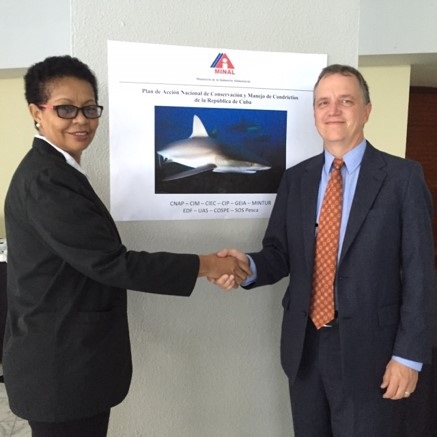Posted on June 10, 2021 by Daniel Whittle
On Valentine’s Day 2015, Cuban and American scientists went fishing off the north coast of Cuba, setting out from Cojimar, the small town where Hemingway kept his boat. They were hoping to catch a rare longfin mako shark, put a satellite tag on it, and then monitor its movements and behavior.
They got lucky. After 10 hours of rough seas, a large adult longfin took the bait and nearly capsized the boat—in the end, they wrestled the shark onto the boat just long enough to tag it and let it go.
It turns out that longfin makos get around. After leaving Cuba, the shark swam the Gulf Stream to The Bahamas and then circled back into the Gulf of Mexico for several weeks. From there, it headed up the Atlantic coast, reaching New Jersey in late June, before swimming south again. The tag popped off in the open ocean later that summer, east of the Chesapeake Bay.
Longfins are highly migratory. Like many other species of marine life – think sea turtles, whales, and even manatees – they travel freely across political boundaries; passports and visas not required. But sharks aren’t immune from the whims of politicians. What happens in one country because of lax environmental policies or programs – like overfishing or marine pollution – can affect marine life, ecosystems and livelihoods across the border.
This is particularly true for sharks – nearly 75% of migratory shark species in the world are “threatened” or “near threatened,” largely because countries do a lousy job of collaborating.
It’s never been any secret that our two countries are connected. Scientific experts on both sides of the Florida straits have been finding ways to team up literally for centuries, through good times and bad. The fruits of their labors are many – discoveries of new species, advances in conserving soils, new approaches for managing pests and invasive species, improved methodologies for tracking hurricanes. The list goes on.
Nonetheless, because of nearly six decades of hostility, environmental cooperation has taken place mostly between non-governmental actors in the United States and a range of governmental and non-governmental institutions in Cuba. Direct government-to-government dialogue on most things has been extremely limited.
Following the normalization in relations between the United States and Cuba in December 2014, this changed. Government agencies started talking again and began working together on a suite of shared environmental problems, from climate change to overfishing and loss of biodiversity. Government and academic scientists from both countries even got in the water together — in 2017 a team of Cubans and Americans spent a month circumnavigating the island, exploring deep water coral reefs, and discovering new species of sponges and other marine life.
From November 2015 to January 2017, the US and Cuba signed 22 bilateral agreements, the first two of which promised cooperation on the environment.

What’s this got to do with the longfin mako? Though some joint research on sharks had occurred before, we never would have been able to secure permission from either government to take technology like satellite tags to Cuba before thawing of relations in 2014. Several months after our expedition, the Cuban government asked for our help in preparing their first-ever National Plan of Action for Sharks – a roadmap for rebuilding populations of the almost 100 species of sharks in Cuba’s waters. With normalization came a measure of normalcy to scientific collaboration.
Environmental protection was a central pillar of U.S.-Cuba bilateral cooperation during the last two years of the Obama Administration, but President Trump replaced a policy of constructive engagement with one of antagonism and isolation. This put government talks on hold; it did not prohibit projects by U.S. NGOs, but did impose a new set of constraints upon them.
One of the most unfortunate outcomes of Trump’s policies was the inability of Cuban scientists to get visas to come to the United States. This severely limited the two-way exchanges that lie at the heart of fruitful and productive collaboration.
With a new administration in Washington, there are new opportunities to not only return things to the way they were in January 2017, but also to deepen and expand engagement.
Last December, 15 U.S.-based environmental and science groups sent a letter to President Biden’s transition team with several recommendations for how to improve cooperation. The letter called upon Biden to reverse Trump’s restrictions and underscored that a progressive Cuba policy would align well with Biden’s agenda on climate, clean energy, and jobs.
Though Biden has yet to act on Cuba policy, many are still optimistic he’ll seize the opportunity to do so soon. Yes, Mr. President, it is safe to go back in the water.

